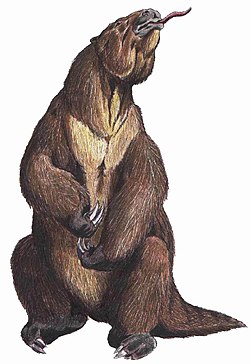| Nothrotherium | |
|---|---|
 | |
| Skull of Nothrotherium | |
| Scientific classification | |
| Kingdom: | Animalia |
| Phylum: | Chordata |
| Class: | Mammalia |
| Order: | Pilosa |
| Family: | † Nothrotheriidae |
| Subfamily: | † Nothrotheriinae |
| Genus: | † Nothrotherium Lydekker, 1889 |
| Species | |
| |
| Synonyms | |
| |
Nothrotherium is an extinct genus of medium-sized ground sloth from South America (Bolivia, Brazil and the Ware Formation, La Guajira, Colombia). [1] It differs from Nothrotheriops in smaller size and differences in skull and hind leg bones.

